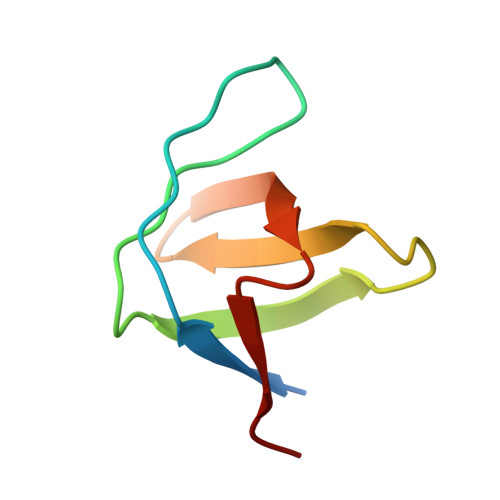Cooperative propagation of local stability changes from low-stability and high-stability regions in a SH3 domain
Casares, S., Lopez-Mayorga, O., Vega, M.C., Camara-Artigas, A., Conejero-Lara, F.(2007) Proteins 67: 531-547
- PubMed: 17330285
- DOI: https://doi.org/10.1002/prot.21284
- Primary Citation of Related Structures:
2CDT, 2F2V, 2F2W, 2F2X - PubMed Abstract:
Site-directed mutagenesis has been used to produce local stability changes at two regions of the binding site surface of the alpha-spectrin SH3 domain (Spc-SH3) differing in their intrinsic stability. Mutations were made at residue 56, located at the solvent-exposed side of the short 3(10) helix, and at residue 21 in the tip of the flexible RT-loop. NMR chemical-shift analysis and X-ray crystallography indicated negligible changes produced by the mutations in the native structure limited to subtle rearrangements near the mutated residue and at flexible loops. Additionally, mutations do not alter importantly the SH3 binding site structure, although produce significant changes in its affinity for a proline-rich decapeptide. The changes in global stability measured by differential scanning calorimetry are consistent the local energy changes predicted by theoretical models, with the most significant effects observed for the Ala-Gly mutations. Propagation of the local stability changes throughout the domain structure has been studied at a per-residue level of resolution by NMR-detected amide hydrogen-deuterium exchange (HX). Stability propagation is remarkably efficient in this small domain, apparently due to its intrinsically low stability. Nevertheless, the HX-core of the domain is not fully cooperative, indicating the existence of co-operative subunits within the core, which is markedly polarized. An equilibrium phi-analysis of the changes in the apparent Gibbs energies of HX per residue produced by the mutations has allowed us to characterize structurally the conformational states leading to HX. Some of these states resemble notably the folding transition state of the Spc-SH3 domain, suggesting a great potential of this approach to explore the folding energy landscape of proteins. An energy perturbation propagates more effectively from a flexible region to the core than in the opposite direction, because the former affects a broader region of the energy landscape than the latter. This might be of importance in understanding the special thermodynamic signature of the SH3-peptide interaction and the relevance of the dual character of SH3 binding sites.
Organizational Affiliation:
Departamento de Química Física e Instituto de Biotecnología, Facultad de Ciencias, Universidad de Granada 18071, Granada, Spain.















